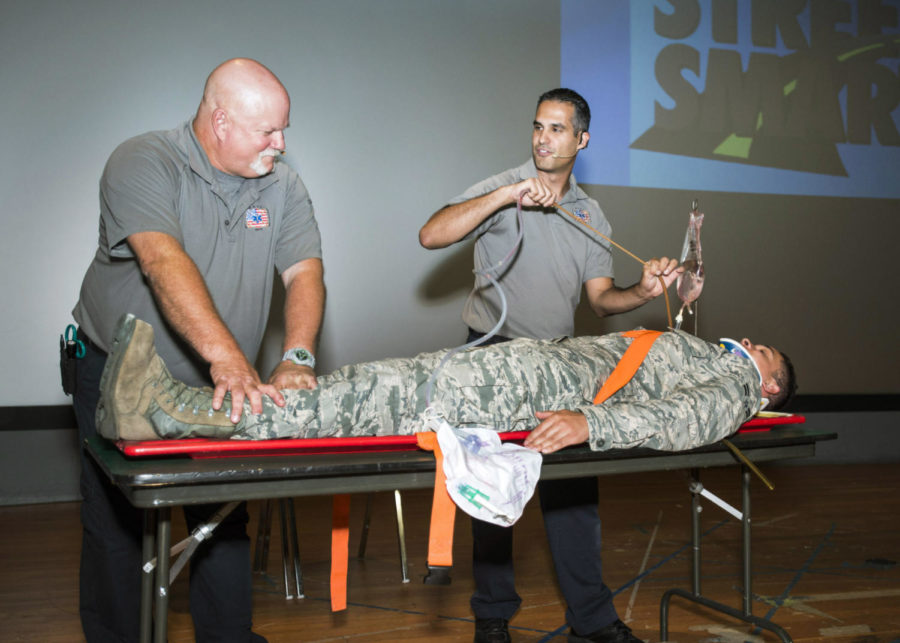Opinion: Street Smart Teaches the Right Lesson the Wrong Way
Media by US AIR FORCE PHOTO BY T.C. PERKI
Travis AFB CA: Mr. Greg McCarty and Oscar Duran both paramedics from Miami-Dade County, Florida give an eye opening demonstration of the tools and evasive procedures used just to keep some one alive until they reach a trauma center after a traffic accident. Airman First Class Isaiah Sylvia a Flight Service Center Journeyman assigned to 60 Logistics Readiness Squadron posed as the unlucky victim who might have been impaired or was not wearing a seat belt during the demonstration. Released USAF Photo by T.C. Perkins Jr.
On April 3rd, freshmen and sophomores suffered through a poorly constructed presentation about general car safety, given by a group called Street Smart. While the innate message of the presentation is one kids should learn, the two people giving the presentation handle the topic insensitively and unprofessionally.
Throughout the presentation, students are shown graphic pictures of car crashes that portray mangled and bloody corpses. In one case, a charred body is the result of forgetting to put on a seatbelt; in a short video clip, students witness a body flung out of a moving vehicle on a highway. While the presenters do allow students to leave the room if they are disturbed by these images, what’s the point of showing so many graphic images? Yes, I agree that students should understand how easily life can be lost in a car accident; however, if students leave the room because of how that message is delivered, then the presenters ultimately fail at what they set out to do.
As for the presenters themselves, they were inconsiderate and melodramatic. Three times throughout both the freshmen and sophomore sessions, the first speaker asked students to raise their hands if they know “a loved one who has died from a trauma incident.” It is disrespectful and insensitive to any students who may be recovering from the death of a loved one.
Another component of the assembly required two students to act as car crash victims, while the speakers act as emergency responders. After a pretend car crash happens, both of the presenters examine the students; the passenger is found dead, while the driver is barely clinging to life. When looking over the passenger, the second speaker flatly comments that it is better to be dead rather than to suffer through surgery. The implication students receive from this is that a car crash either means the end of their life or a path to recovery that is worse than death.
Despite Street Smart’s fear mongering, research shows that students should not actually be worried about getting into a car the next time they have the chance. The Insurance Information Institute, an organization founded in 1959 that gives people an understanding of insurance and road safety, reports that there is only a 1 in 645 chance to be injured in a car accident.
A statistic from the Federal Highway Administration tells that out of 3.22 trillion miles of public roads in the US compared to 6 million recorded accidents causes for only 5.33 percent of US drivers to be considered “bad drivers” (a bad driver would be considered someone who endangers others while on the road).
And even with all of Street Smarts’ faults, I still find myself agreeing with what is at the heart of their message. Teenagers need to understand that death is a real concept and that it can happen instantly to anyone at any time. But teaching students that lesson with fear is not the way to go about it and it never should be.
Your donation will support the student journalists of Marquette High School. Your contribution will allow us to purchase equipment and cover our annual website hosting costs. You may become a PATRON by making a donation at one of these levels: White/$30, Green/$50, Blue/$100. Patron names will be published in the print newsmagazine, on the website and once per quarter on our social media accounts.

Shirley Roach, senior, has been the Opinions editor for the Messenger since 2018. Shirley is also the president of Movie Appreciation Club and a member...




Dominc • Apr 10, 2018 at 3:11 PM
I strongly agree with you they did send the right message but they did not do it in a way that did not offend or disgust most of the people sitting through that presentation